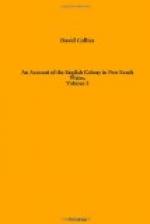On being broken transversely, it was immediately seen that the internal part was divided into interior or central, exterior or cortical. The exterior part, which in different specimens occupied various proportions of the whole, resembled a fine white and soft grit-stone; but acids being applied, showed it to be combined with a considerable portion of calcareous matter. The interior or central part was always circular, but seldom found of the same diameter, or of the same composition, on any two stumps. In some the calcareous and sandy matter had taken such entire possession, that every fragment of the wood was completely obliterated; but yet a faint central ring remained. In others was a centre of chalk, beautifully white, that crumbled between the fingers to the finest powder; some consisted of chalk and brown earth, in various quantities, and some others had detained a few frail portions of their woody fibres, the spaces between which were filled up with chalky earth.
It appeared, that when the people of the Sydney Cove first came upon the island, the pieces of dead branches that at this time were lying round the stumps, then formed, with them, the stem and branches of dead trees complete. But by the time Mr. Bass visited the place, the hands of curiosity, and the frolics of an unruly horse that was saved from the wreck, had reduced them to the state already described.
Mr. Bass had been told from good authority, that when the trees were in a complete state, the diameter of the dead wood of the stem that rose immediately from the stoney part was equal to the diameter of that part; and also that a living leaf was seen upon the uppermost branches of one of them. But he could never learn whether the stony part of the stem was of an equal height in all the trees.
To ascertain to what depth the petrification had extended, Mr. Bass scratched away the sand from the foot of many of the stumps, and in no instance found it to have proceeded more than three or four inches beneath the surface of the sand, as it then lay; for at that depth the brown and crumbling remains of the root came into view. There were, indeed, parts of the roots which had undergone an alteration similar to that which had taken place in the stems: but these tended to establish the limits of the petrifying power; for they had felt it only either at their first outset from the bottom of the stems, or when, being obstructed in their progress, they had of necessity arched upwards toward the surface.




